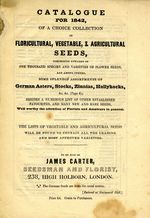An increased flow of exotics from the Middle East, South Africa and the Americas appeared in England at the end of the eighteenth century, encouraging a love of plant collecting and botany among the upper classes, as well as among tradesmen who competed and developed ideal forms of “florists’ flowers”.1 By the nineteenth century, the enthusiasm for botany, flowers, and exotic plants was spreading to all levels of society. After 1840, the seed and nursery trade expanded exponentially along with railways, improved mail service, and annually published booklet catalogues.
The OSU collection contains catalogues of two London firms that offered seeds, plants and bulbs: ten issued by James Carter, ranging from 1839 to 1848, two catalogues by Westmacott & Co. from 1846, and one of 1847 from the latter firm’s successor, Robert Westmacott. According to historian John Harvey, Carter’s catalogue of 1837 marked a milestone in the history of British catalogues. Published in the year when Queen Victoria ascended to the throne, it was one of the earliest to be issued annually in booklet form.2 Carter’s catalogues “were for many years the index of educated horticultural taste”.3 The firm of James Carter eventually became Carter’s Tested Seeds, for which the OSU collection also contains several catalogues from the twentieth century.
Martin Westmacott, who called himself “Seedsman and Florist”, founded Stuart’s Grove Nursery, and took over the former Lockhart’s Nursery in Fulham in 1845.4 Robert Westmacott carried on the business from 1847.5 On this page are scans of James Carter’s 1842 Seed Catalogue, as well as that of Westmacott & Co. from 1846. Both companies’ catalogues list prices and provid botanical names of plants. They also contained several innovations which first appeared in catalogues during the 1830s: item numbers and descriptive flower charts.6
Notes
- Florists flowers in the late eighteenth century included dianthus, auriculas, anemones, ranunculi, polyanthuses, hyacinths and tulips. See Nicolette Scourse, The Victorians and their flowers, (London & Canberra, Croom Helm and Portland, Timber Press, 1983) 23
- John H. Harvey, Early Nurserymen (London, Phillimore, 1974) 8
- John H. Harvey, “Nurseries, Nurserymen and Seedsmen,” The Garden: A Celebration of One Thousand Years of British Gardening, The guide to the exhibition presented by the Victoria and Albert Museum, (London, New Perspectives Publishing, 1979) 110, also quoted in Elinor M.C. Roper, Seedtime.
- E. J. Willson, West London Nursery Gardens: the nursery gardens of Chelsea, Fulham, Hammersmith, Kensington and a part of Westminster, founded before 1900, (Greenwich, The Fulham and Hammersmith Historical Society, Morganprint (Blackheath) 1982) 111
- Willson 111
- John H. Harvey, Early Gardening Catalogues (London and Chichester, Phillimore, 1972) 50


